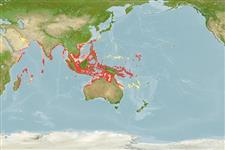>
Clupeiformes (Herrings) >
Dorosomatidae (Gizzard shads and sardinellas)
Etymology: Anodontostoma: Greek, ana = up + Greek, odous = teeth + Greek, stoma = mouth (Ref. 45335).
More on author: Hamilton.
Environment: milieu / climate zone / depth range / distribution range
Écologie
marin; eau douce; saumâtre; anadrome (Ref. 51243); profondeur 0 - 50 m (Ref. 188). Tropical; 31°N - 23°S, 47°E - 171°E (Ref. 188)
Indo-West Pacific: Persian Gulf to coasts of India and Andaman Sea, to Gulf of Thailand, Indonesia, Viet Nam, and Philippines, south to northern Australia, the Caroline Islands and New Caledonia.
Length at first maturity / Taille / Poids / Âge
Maturity: Lm 14.1 range ? - ? cm
Max length : 22.0 cm SL mâle / non sexé; (Ref. 54980); common length : 14.0 cm SL mâle / non sexé; (Ref. 3107)
Épines dorsales (Total) : 0; Épines anales: 0; Rayons mous anaux: 17 - 25. Body depth increasing with size of fish, 40 to 70 % standard length in fishes over 10 cm. Second supra-maxilla a mere splint. Longest gill rakers on lower part of arch less than corresponding gill filaments. Hind edges of scales toothed, the teeth thinner than the gaps between them; a median series of pre-dorsal scales. A large black spot behind gill opening.
Pelagic inshore (Ref. 68964). Usually marine coastal, but ascends rivers to the upper tidal zone (Ref. 12693). Occurs inshore and also in estuaries. Feeds on diatoms, radiolarians, mollusks, copepods, and crustaceans (in that order of importance, at least in the Godavari estuary). Breeds from November to February, mainly in the later part (Godavari estuary). Marketed fresh, frozen, dried, dried-salted or boiled. Made into fish balls.
Whitehead, P.J.P., 1985. FAO Species Catalogue. Vol. 7. Clupeoid fishes of the world (suborder Clupeoidei). An annotated and illustrated catalogue of the herrings, sardines, pilchards, sprats, shads, anchovies and wolf-herrings. FAO Fish. Synop. 125(7/1):1-303. Rome: FAO. (Ref. 188)
Statut dans la liste rouge de l'IUCN (Ref. 130435: Version 2024-2)
Menace pour l'homme
Harmless
Utilisations par l'homme
Pêcheries: commercial
Outils
Articles particuliers
Télécharger en XML
Sources Internet
Estimates based on models
Preferred temperature (Ref.
123201): 26.5 - 29.1, mean 28.3 °C (based on 1250 cells).
Phylogenetic diversity index (Ref.
82804): PD
50 = 0.6250 [Uniqueness, from 0.5 = low to 2.0 = high].
Bayesian length-weight: a=0.00891 (0.00780 - 0.01019), b=3.05 (3.01 - 3.09), in cm total length, based on LWR estimates for this species (Ref.
93245).
Niveau trophique (Ref.
69278): 2.8 ±0.28 se; based on food items.
Generation time: 1.3 ( na - na) years. Estimated as median ln(3)/K based on 2
growth studies.
Résilience (Ref.
120179): Haut, temps minimum de doublement de population inférieur à 15 mois (K=0.9-1.3).
Prior r = 1.19, 95% CL = 0.79 - 1.79, Based on 4 data-limited stock assessments.
Fishing Vulnerability (Ref.
59153): Low vulnerability (14 of 100).
Climate Vulnerability (Ref.
125649): Moderate to high vulnerability (51 of 100).
Nutrients (Ref.
124155): Calcium = 282 [162, 519] mg/100g; Iron = 2.3 [1.3, 3.8] mg/100g; Protein = 19 [18, 20] %; Omega3 = 0.416 [0.233, 0.743] g/100g; Selenium = 53.1 [26.1, 110.1] μg/100g; VitaminA = 12.1 [4.9, 28.2] μg/100g; Zinc = 2.17 [1.53, 3.17] mg/100g (wet weight);
